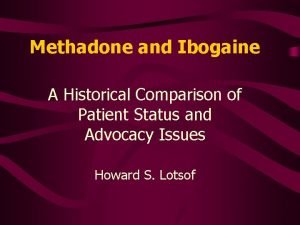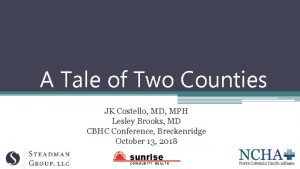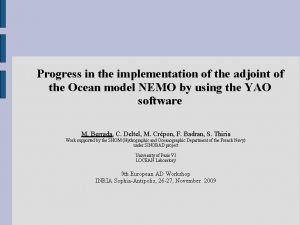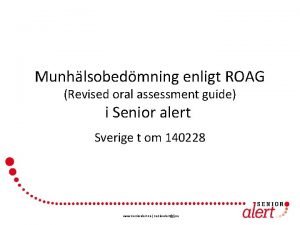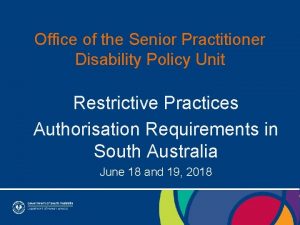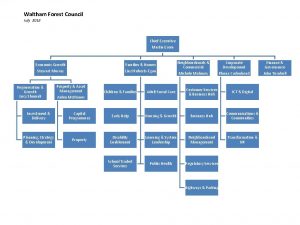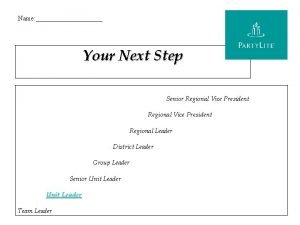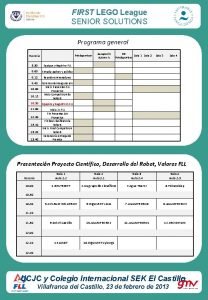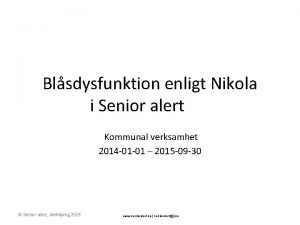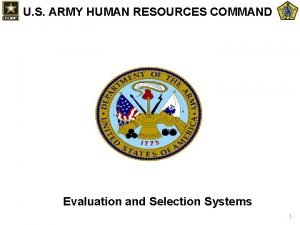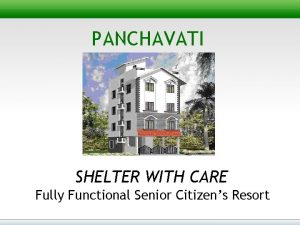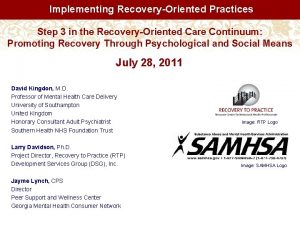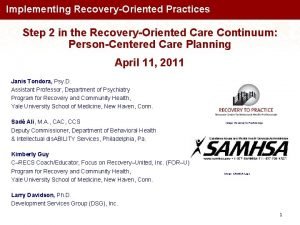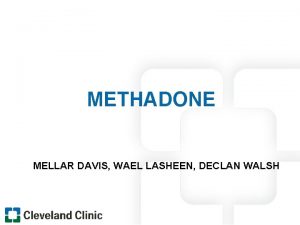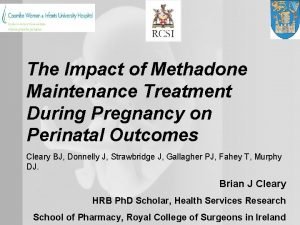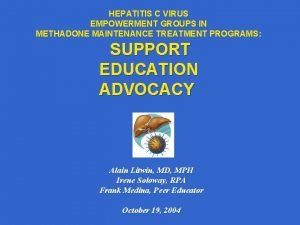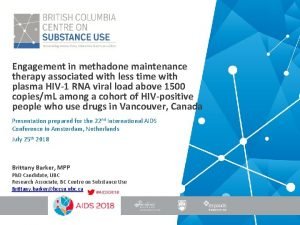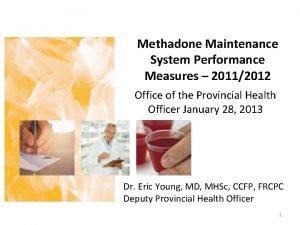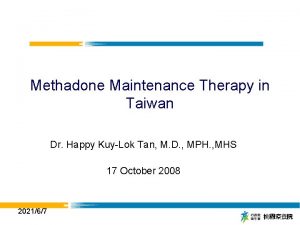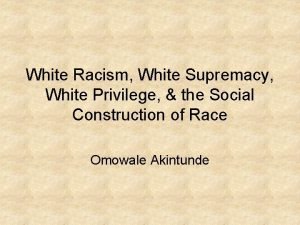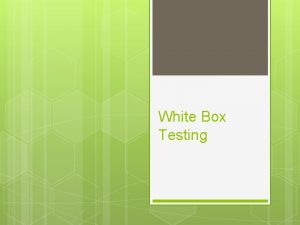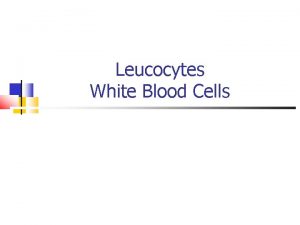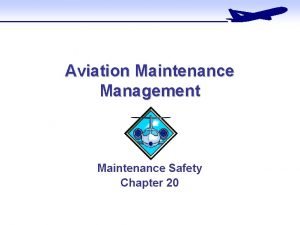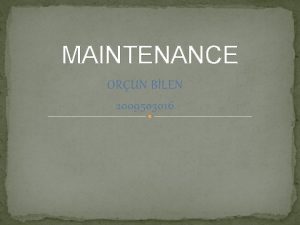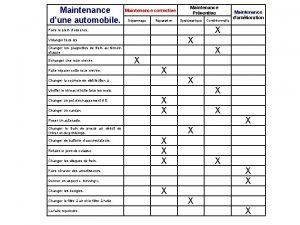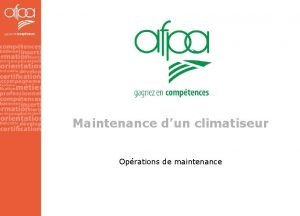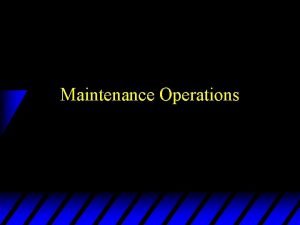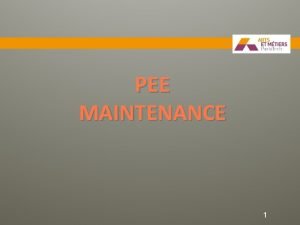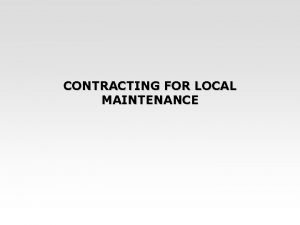RecoveryOriented Methadone Maintenance William L White MA Senior


































- Slides: 34

Recovery-Oriented Methadone Maintenance William L. White, MA Senior Research Consultant Chestnut Health Systems bwhite@chestnut. org “I am not my disease, and I am not my medication. ” --Methadone Patient, 2009

Dedication: Dr. Ed Senay & Lisa Mojer-Torres, J. D.

Presentation Goals �Describe changes in recovery-oriented practices within the evolution of methadone maintenance treatment (MMT) �Identify at least 3 concerns that led to call for increased recovery orientation of MMT �Define Recovery-oriented MMT (and what it is NOT) �List at least 5 service ingredients that distinguish ROMM �Discuss strategies to reduce social and professional stigma attached to MMT and broader arena of medication-assisted treatment and recovery

A Note on Note-taking & Resources �The information reviewed in this webinar is detailed with full citations in the 2010 White & Mojer-Torres monograph, Recovery-oriented Methadone Maintenance, and the other publications noted on the last slides. All are available for free download at www. williamwhitepapers. com �The slide of this presentation will be posted for download.

The Historical Context for the Development of MMT Technology Drug Promotion Specialized Treatment • Isolation of Morphine • Hypodermic Syringe • Patent Medicine Industry • Homes, Asylums, Institutes • Fraudulent Cures

Iatrogenesis: Harm in the Name of Help

The Historical Context for the Development of MMT Collapse Of 19 th Century Tx Narcotics Farms Mid-20 th Century rise in Heroin Addiction • • Harrison Act Webb V. United States 1919 -1924 Clinics Experimental, e. g. , Bromide Therapy • • Porter Act (1929) Lexington, KY (1935) Fort Worth, Tx (1938) High Post-Tx Relapse Rates • Juvenile Narcotic Addiction & Riverside Hospital (52 -61) • Moral Panic • Vietnam

Therapeutic Pessimism Sparks Search for New Tx Approaches �Psychoanalysis and Psychotherapy �Serum Therapy, ECT, Psychosurgery, LSD, ECT, Aversion Therapy, �Grassroots community counseling clinics (1950 s) �Mutual Aid via Addicts Anonymous (1947) & Narcotics Anonymous (1953; near death in 1959; limited growth) �Therapeutic Communities (Synanon, 1958) �Civil Commitment �Narcotic Antagonists (e. g. , naloxone, naltrexone) �Methadone Maintenance

MMT Pioneers �Dr. Vince Dole �Dr. Marie Nyswander �Dr. Mary Jeanne Kreek �MMT as a Patientcentered medical treatment �Role of Psychosocial Support �Dole/Nyswander AA/NA involvement

Recovery Orientation of Early MMT �Rapid Access to Tx �Emphasis on Therapeutic Alliance �Blockade Doses (80 -120 mgd) �No limits on duration of MMT �Programs for special populations �Recovering staff as role models

Regulation & Mass Expansion Federal and widely varying state and local regulation of MMT Rapid Growth under Nixon Administration � 22 patients in 1965 � 400 patients in 1968 � 36, 000 patients in NYC in 1972 � 80, 00 patients in US in 1976 Present � 260, 000 MMT patients in 2008 (in 1, 132 certified OTPs) �Estimates of persons addicted to opiates in US range between 750, 000 -1, 000

Regulation & Mass Expansion Decreased recovery orientation via �Shift in focus from personal recovery to reduction of social costs, e. g. , crime and infectious disease �Widely varying quality of MMT clinics �Reduction of average methadone doses to sub-therapeutic levels �Decreased duration of MMT with increased pressure to end medication maintenance �Erosion of ancillary services, particularly in 1980 s �Preoccupation with mechanics of dosing rather than larger process of recovery

Early Methadone Critics Alleged: �Substitutes one addictive drug for another �Conveys permissiveness towards drug use �Fails to address characterological or social roots of heroin addiction �Impairs patients cognitively, emotionally, behaviorally �Is a tool of racial oppression �Is financially exploitive �Public/professional stigma left MMT & patients in a cultural limbo

Revitalization of MMT (1990 present) �Reaffirmation of MMT effectiveness by leading scientific, professional and governmental bodies �Advocacy efforts of MMT patients (e. g. , AFIRM, NAMA-R) �Expansion of pharmacotherapy choice, e. g. , buprenorphine �Expansion of MMT in private sector following erosion of public funding �Focus on elevating quality of MMT �Accreditation of Opioid Treatment Programs

Setting the Stage for ROMM �Understanding Opioid Addiction as a Chronic Disorder �Emergence of Recovery as New Organizing Paradigm in Addictions Field �Efforts to Extend Acute & Palliative Models of Care to Models of Assertive Recovery Management (RM) & Recovery-Oriented Systems of Care (ROSC) �Questions of Implications of RM & ROSC to Medication-Assisted Treatment (MAT)

Emerging Recovery Definition Sobriety (abstinence / remission) Global Health Citizenship

Limbo Status of the MM Patient Positing recovery as a journey of self-transformation, the methadone patient subsists in undetermined space—a hinterland beyond the clearly demarcated identity fissures of “addict” or “recovering addict. ” In the absence of a proactive recovery culture, the methadone maintenance patient becomes tied to an archetypal “spoiled identity” to be managed and governed rather than retrieved, nurtured and healed (Bamber, 2010).

Recovery & Medication Status BFI Consensus Statement “…formerly opioid-dependent individuals who take naltrexone, buprenorphine, or methadone as prescribed and are abstinent from alcohol and all other nonprescribed drugs would meet this definition of sobriety” (Journal of Substance Abuse Treatment, 2007)

Growing Professional Consensus For MAT patients who achieve recovery via these three dimensions, continued participation in medication maintenance or eventual tapering and recovery without medication support represent varieties of recovery experience and matters of personal choice, not the boundary of passage from the status of addiction to the status of recovery. (White, 2012, Journal of Addictive Diseases)

This perspective requires: Distinguishing • Physical Dependence • Tolerance, Withdrawal • Addiction • Craving, obsession, compulsion • Drugs that compromise recovery status • Medications that may enhance recovery stability

This Perspective Requires Challenging Methadone Myths, such as 1. • Methadone is “addicting. ” • Stabilized MM patients do not meet criteria for DSM-IV opioid dependence 2. • Methadone is intoxicating and impairing • Stabilized patients do not experience intoxication from optimal doses of methadone nor are they impaired by the medication 3. • Those on lower doses of methadone and shorter duration of methadone have better long-term recovery prospects • Studies suggest the exact opposite

ROMM Defined ROMM is an approach to treatment of opioid addiction that combines medication and a sustained menu of professional and peer-based recovery support services to assist patients and families in initiating and maintaining long-term recovery.

Problems of MMT addressed by ROMM include: �Low rate of attraction (6 -15 years before 1 st admission; 22 years prior to achieving recovery stability) �Problems of access (25 -50% of persons on waiting list drop out before admission) �Subclinical dosing and dose manipulations or administrative discharge for rule infractions �Continued drug use while in MMT related to withdrawal distress (often linked to subtherapeutic doses of methadone), dysphoric emotional states, pleasure-seeking, and impulsive responses to social opportunities to use (Best et al. , 1999).

Problems of MMT addressed by ROMM include: �Low rate of sustained engagement (24% drop-out in first 60 days; 60. 2% drop-out by one year) �High rate of drop-out/discharge without planned tapering (11% as planned; 45% drop out; 17% transferred; 13% AD; 15% other) �High rate of post-discharge relapse (50%+ in first year after discharge; most in first 30 days) and high mortality risk (820 times greater than patients in treatment) �Low linkage to indigenous recovery communities or alternative recovery support institutions �Role of self-stigma and professional/social stigma attached to MMT as obstacle to community reintegration

ROMM does NOT: �Raise the bar of admission to MMT �Set arbitrary limits on dosage or duration of MMT �Impose pressure for patients to end MMT �Force counseling or peer support services on patients who do not want or would not benefit from them �Extrude patients who do not adopt the goal of full recovery �Impose remission/recovery criteria on MMT patients different that those applied to other patients with SUDs.

ROMM Does Seek To: �Attract people at earlier stages of problem development -Assertive community education & outreach �Ensure rapid access to MMT / Resolve obstacles to Tx -Streamlined intake and assertive waiting-list management �Assure safe, individualized, optimum dose stabilization -Close medical monitoring during induction; individualized dosing philosophy, signs of clinical deterioration prompt rapid dose re-evaluation & need for ancillary services �Engage and retain individuals/families in a sustained recovery support process

ROMM Does Seek To: �Utilize assessment processes that are global, familycentered, strengths-based and continual -Examples, ASI, GAIN �Transition each patient from a professionally-directed treatment plan to a patient-directed recovery plan -Former aimed at remission (-); latter aimed at recovery (+) �Expand the service team -e. g. , primary care physicians, family therapists, peer specialists �Shift the service relationship from a directive expert model to a recovery partnership/consultation model

ROMM Does Seek To: � Assure minimum/optimum duration of MMT -Minimum 1 -2 years (Patients who taper after 1 -2 years have better long- term post-Tx outcomes than those ending treatment before 1 year) -Option of prolonged, if not lifelong, maintenance -Focus is on recovery not duration of medication support � Expand the service menu & imbed services in vibrant culture of recovery -Expanded menu of ancillary services -C of A to C of R; RC infused treatment milieu -Recovery is contagious � Extend delivery of recovery support services into the community -e. g. , C 0 -location; delivery of recovery support services outside the clinic

ROMM Does Seek To: �Link patients/families to recovery community support resources -Assertive versus passive linkage procedures �Provide post-treatment monitoring, support and, if and when needed, early re-intervention. -Recovery checkups & re-engagement �Evaluate MMT using proximal and distal indicators of long -term personal and family recovery -Moving beyond short-term HR outcomes (mortality, crime, disease) to long-term measures of global health, quality of life and community contribution �Conduct anti-stigma campaigns aimed at patients, families, staff, allied professionals and the community.

Strategies to Address Professional/Social Stigma 1. • Protest 2. • Education 3. • Contact

Missing Voices in MMT Discussions �Patients and Families �Need for vanguard of individuals/families to put faces and voices on medication-assisted recovery �There are signs that this vanguard is emerging �That vanguard needs to be engaged in RM/ROSC/ROMM design and evaluation efforts

References �White, W. & Torres, L. (2010). Recovery-oriented methadone maintenance. Chicago, IL: Great Lakes Addiction Technology Transfer Center, Philadelphia Department of Behavioral Health and Mental Retardation Services and Northeast Addiction Technology Transfer Center. �White, W. (2011). Narcotics Anonymous and the pharmacotherapeutic treatment of opioid addiction. Chicago, IL: Great Lakes Addiction Technology Transfer Center and the Philadelphia Department of Behavioral Health & Developmental dis. Abilities Services.

References �White W, Parrino M, Ginter W. A dialogue on the psychopharmacology in behavioral healthcare: the acceptance of medication-assisted treatment in addictions. Commissioned briefing paper for: SAMHSA Dialogue on Psychopharmacology in Behavioral Healthcare; 2011 Oct 11 -12. �Betty Ford Institute Consensus Panel. (2007) What is recovery? A working definition from the Betty Ford Institute. J Subst Abuse Treat 33: 221 -228.

References �White, W. (2012). Recovery orientation in methadone maintenance: A definitional statement. Posted at www. williamwhitepapers. com �White, W. (2012) Medication-assisted recovery from opioid addiction: Historical and contemporary perspectives Journal of Addictive Diseases, . 31(3), 199206. �All References available for free download at www. williamwhitepapers. com
 Sts methadone clinic
Sts methadone clinic Ibogaine methadone
Ibogaine methadone Methadone clinic durango co
Methadone clinic durango co Nonsense poem
Nonsense poem Ellen g white biography
Ellen g white biography Adjoint e graphique senior
Adjoint e graphique senior Final project presentation template
Final project presentation template Saeb is a high school senior
Saeb is a high school senior Roag formulär
Roag formulär Office of the senior practitioner
Office of the senior practitioner Andrew youngson
Andrew youngson Vad är senior alert
Vad är senior alert Senior citizen
Senior citizen Waltham forest senior management structure
Waltham forest senior management structure Marshall bruce mathers 111
Marshall bruce mathers 111 Nbsc meaning
Nbsc meaning Graduation meeting agenda
Graduation meeting agenda Vocational senior high school
Vocational senior high school Courtesies definition
Courtesies definition Erf form for teachers deped
Erf form for teachers deped Senior regional vice president
Senior regional vice president Fll senior solutions
Fll senior solutions Senior alert blankett
Senior alert blankett Senior class motto
Senior class motto Ees army evaluation system
Ees army evaluation system Miami sunset senior high football
Miami sunset senior high football Senior g friendship thursday
Senior g friendship thursday Senior citizen india
Senior citizen india Panchavati senior citizens home bangalore
Panchavati senior citizens home bangalore All things considered being a senior offers a student
All things considered being a senior offers a student Naviance potomac senior high school
Naviance potomac senior high school Sabal palm assisted living palm coast
Sabal palm assisted living palm coast Gearing up for the future (senior high school)
Gearing up for the future (senior high school) Senior anglo vernacular certificate
Senior anglo vernacular certificate Senior citizen traduction
Senior citizen traduction

